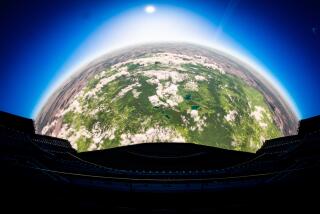Finding Links Between Science and Fun
- Share via
How does one meld miniature golf with an education in natural science?
It’s a question that has no doubt racked the brains of golfing scientists for years. And when the labs, the links and the classrooms came together, “Par for the Planet: Save the World in 18 Holes” was born.
The traveling indoor exhibit, which made its West Coast debut last weekend at the Discovery Science Center in Santa Ana, continues its run through Sept. 10. It is organized and circulated by the Academy of Natural Sciences of Philadelphia.
“It was something that fit in perfectly with the natural sciences here at the center,” said Discovery Science Center spokesman Christopher Trela, about the decision to add the summer exhibit to Discovery’s hands-on experience. “And it’s a lot of fun.”
Like real golf, there is a “front-nine” and a “back-nine” to the “Par for the Planet” exhibit. The front nine of the course illustrates how nature works, while the back nine shows human interaction with the biosphere.
Daunting subjects? In a textbook, maybe, but not so much here. Here’s how it works:
A descriptive placard introduces each tee with a title like, “Rainforest Threats,” and its “hole story,” presenting the theme and particular environmental dilemma.
On Hole 11, for example, the ball represents a spawning salmon that you putt through natural and human-created obstacles in its quest to complete its life cycle.
Other holes include colorful Astroturf educations in the butterfly life cycle, bat sonar, food chains, natural selection, water pollution, recycling, bird migration and dinosaur extinction.
It may seem a bit cerebral in description, but the consensus of most parents putting through the course this week was that their kids will most likely get more from “Par for the Planet” than from the traditional miniature golf experience of whacking the ball until it chips paint off the rusty windmill.
“I was glad to see it here,” said Janet Malloy, 37, of Costa Mesa, trailing her 11-year-old son, Shane, through the exhibit Monday, “He was begging me to go miniature golfing last weekend, but it was too hot. This is great. . . . He learns something, and I don’t have to mess with the sunscreen.”
Laura Overton, 32, of Glendora said a learning atmosphere within a miniature golf course is refreshing when you’re trying to find quality ways to fill summer days.
“It teaches them a lot of different things,” she said, guiding son, Jacob, 7, and daughter, Raylee, 5, past the giant toad at the “Predator and Prey” eighth hole.
“I don’t know how much they’re picking up, but at least it’s here,” she said.
Whether it’s hunger for a hole-in-one or thirst for environmental science knowledge driving them to play, the adults and kids on the links seemed to be having a good time.
Michael Chan, 8, got a hole-in-one on the “Seed Dispersal” hole, after correctly putting toward the animal that would best disperse seeds for survival. Several holes later, the Diamond Bar youngster was holding onto his indoor handicap, but confessed with a sideways nod to retaining little of the “science stuff.”
“At least he’s honest,” said his mom with a smile. “We’re just here to have fun.”
BE THERE
“Par for the Planet: Save the World in 18 Holes,” Discovery Science Center, 2500 N. Main St., Santa Ana. Open daily, 10 a.m. to 5 p.m. Regular admission: free for 2-year-olds and younger; $7.50 for youths 3-17; $9.50 for adults; $7.50 for older than 55. Parking, $3. Par for the Planet is $2 in addition to admission price. Continues through Sept. 10. For more information: (714) 542-CUBE, or visit https://www.dis coverycube.org.
More to Read
Sign up for The Wild
We’ll help you find the best places to hike, bike and run, as well as the perfect silent spots for meditation and yoga.
You may occasionally receive promotional content from the Los Angeles Times.






